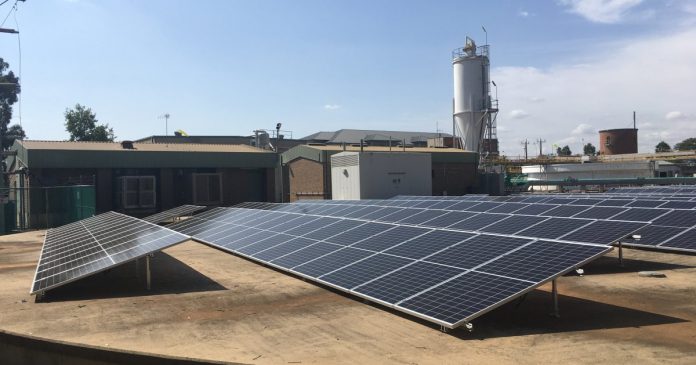Victoria’s Goulburn Valley Water’s PV project is well under way, with thousands of solar panels already installed and more than a thousand modules yet to be.
Goulburn Valley Water (GVW) provides water and wastewater services to a population of around 125,000 in 54 towns from the outskirts of Melbourne in the south to the Murray River in the north. Its network includes 37 water supply systems and 26 wastewater management facilities.
In September last year, GVW announced a project to install 1.9 megawatts of solar capacity spread across 16 systems at sites in ten GVW townships. Once fully rolled out, the utility says it expects an average annual solar energy output of more than 3,000 megawatt hours collectively from the systems, while avoiding 4,500 tonnes1 of carbon dioxide equivalent each year.
As at February 6, installation of 3,200 solar panels at 6 sites had been completed. The largest installation was at the wastewater management facility in Daldy Road, Shepparton North – 1,900 panels.
Installations under way at the time were a 120-panel system at Kilmore, 120 panels at Tongala and 60 at Rushworth water treatment plants.
“Our solar panel installation project is progressing well and we’re really excited to see the panel arrays taking shape,” said Goulburn Valley Water on Thursday.
It’s expected installations involving a total of 1,165 modules at facilities in Cobram, Shepparton, Kyabram and Broadford will start next month.
GVW’s Emission Reduction Efforts
Other renewable energy efforts by GVW include the use of biogas from sewage at its Shepparton and Tatura Wastewater Management Facilities that has been used to generate more than 40,000 megawatt-hours of electricity to date.
Even before the addition of solar panels, Goulburn Valley Water had made solid progress in emissions reductions through biogas management and energy efficiency programs. In 2016/17 its reported net emissions were 40,581 tonnes, compared to 71,087 tonnes in 2001/02 – a reduction of more than 40 percent.
GVW has an obligation to reduce its carbon emissions to 37,416 tonnes of carbon dioxide equivalent annually by 2025 – and based on the 2016/17 level combined with the added solar energy related reductions, it looks set to meet that.
Australia’s water and wastewater utilities collectively consume a huge amount of electricity – I’ve seen figures ranging from 1,550 GWh – 3,000 GWh a year. Increasingly utilities are turning to renewables not just as a way of slashing electricity related emissions, but also to reduce energy costs.
Analysis by researchers at UQ’s School of Chemical Engineering indicated the Australian water industry generated 279 GWh of its electricity from on-site renewables in 2018.






